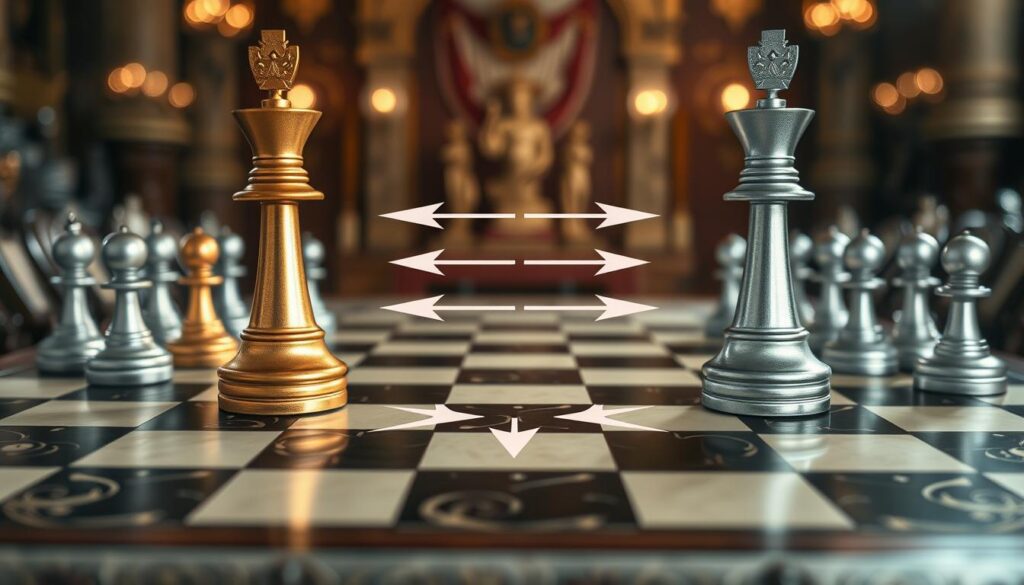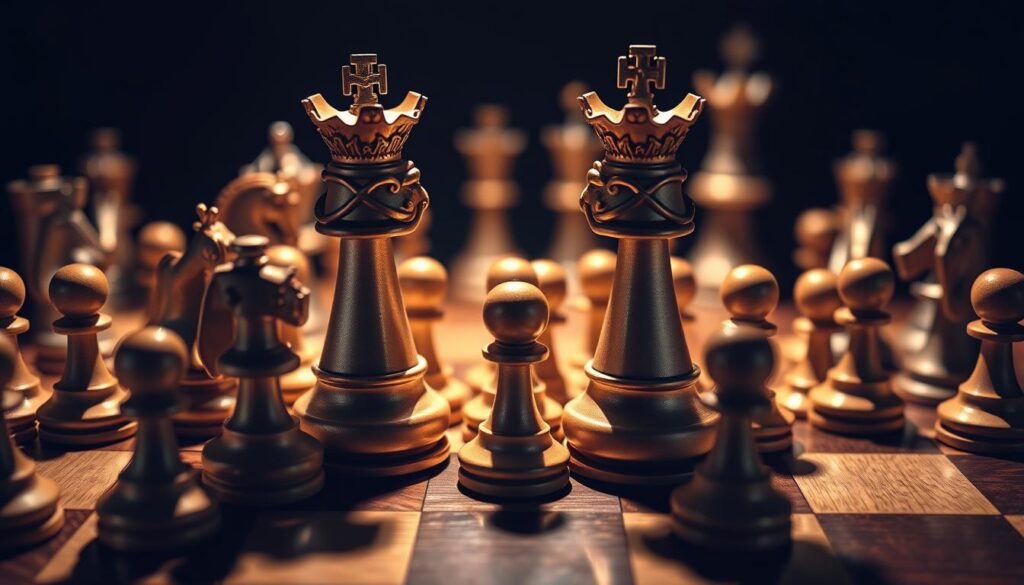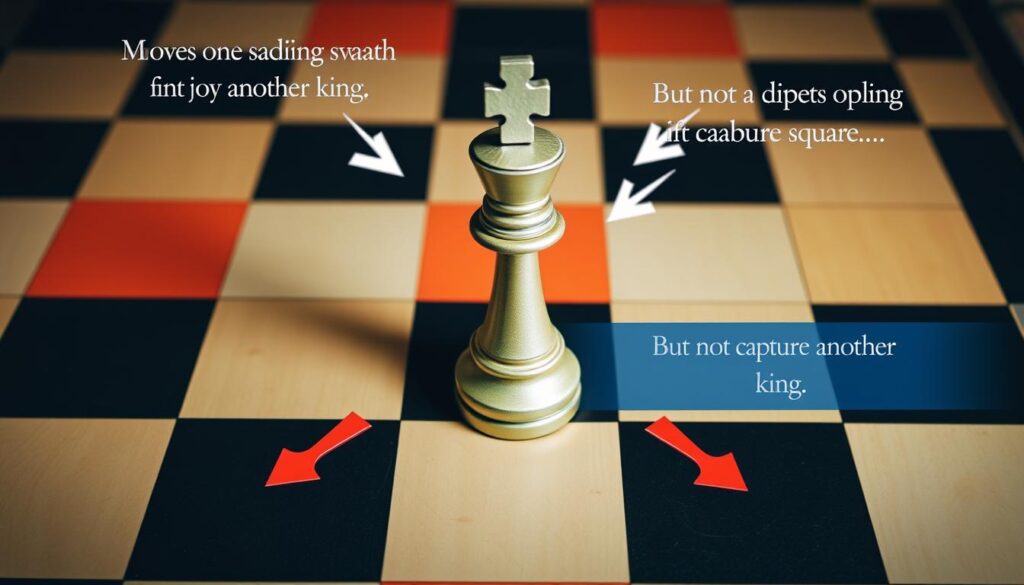Ever thought about what happens when two kings meet in chess? Knowing how kings move is key to winning at chess.
Chess rules are complex, and king movement in chess is no exception. The king is vital, but it can’t be captured in the usual way. This makes the game full of strategy and surprises.
When you learn about chess, you find out kings can only move one square at a time. This rule makes the king both weak and very important in the game’s outcome.
Table of Contents
Understanding the King’s Role in Chess
In chess, the king is the most important piece. It’s different from others because it can’t move far. Its survival is key to winning the game.
The king can only move one square in any direction. This makes it hard to protect. If your king is captured, you lose.
Protecting the king is crucial. It can move horizontally, vertically, or diagonally, but only one square at a time. This limited movement makes it important to position it well.
Professional players know the king is not just for hiding. In the endgame, it becomes active. Centralizing the king can help you win by supporting pawns.
The king can’t capture another king, but its position is crucial. Learning to use it well is key. Your skill in protecting and positioning the king will show your chess level.
Can a King Take a King in Chess

In chess, kings have special rules when it comes to capturing pieces in chess. They can move into a square where an opponent’s piece is, removing it from the board. But, there’s a key rule that makes kings different from other pieces.
The main rule in chess is that kings can’t capture each other. This chess rules helps keep the game strategic and avoids impossible situations. Your king’s role is to protect itself and help control the board.
Kings must stay safe from each other in chess. The chess rules of opposition says kings can’t be next to each other or capture each other. If a king could take another king, the game would be unplayable, breaking chess rules.
Knowing how kings capture pieces means understanding their movement limits. While kings can remove pieces in one square, they can’t fight another king directly. This rule is true for all chess games, from casual to professional.
The real value of kings in chess isn’t in capturing pieces. It’s in their role as the most important piece on the board. Keeping your king safe and placing it wisely is key to winning in chess.
Legal and Illegal Moves Involving Kings

Mastering chess starts with knowing the rules. The king can move one square in any direction. This makes keeping your king safe a key strategy.
Some moves are not allowed in chess. Moving your king into check is one of them. If your king can be captured, the move is invalid. Always think about your king’s safety when planning moves.
In chess tournaments, making an illegal move can be costly. You might lose the game if you make another mistake. Time is of the essence – in rapid chess, pointing out an illegal move can give you extra time.
Your king’s main job is to defend. It can’t be captured but can be in checkmate. Knowing these rules will make you a better player.
Success in chess comes from protecting your king and still attacking. Practice to get better at spotting legal and illegal moves.
How Kings Interact With Other Pieces (king movement in chess)

In chess, the king’s role is both strategic and nuanced. It’s not just a passive piece. The king can be key in both attacking and defending. Knowing how the king interacts can greatly boost your chess skills.
In the early and middle game, the king stays safe, avoiding fights. Strategic king use shines in the endgame. Here, the king becomes active, supporting pieces, controlling squares, and pushing pawns.
As the game unfolds, the king’s role evolves. It can set up strong defenses, stopping opponents from getting close. By placing the king wisely, you can control key areas and restrict your opponent’s moves.
In the endgame, top players use the king to attack. With fewer pieces, the king moves freely. It can capture pieces or help pawns reach promotion. Mastering these king interactions can lead to victory.
The King’s Movement Limitations

Knowing how the king moves is key to a good chess strategy. Your king is special because it can only move one square at a time. It can go left, right, up, down, or diagonally.
Keeping your king safe is very important. Because it moves so little, you need to plan its moves carefully. You can’t move it into danger, which makes the game even more challenging.
Chess is all about using the king’s limited movement to your advantage. This rule keeps the king from getting too strong. It makes protecting it a game of strategy and piece placement.
Top players know the king’s limited movement makes it both weak and vital. It can’t attack pieces that would put it in danger. But, it’s still the most important piece. How well you manage its movement can win you the game.
Remember, mastering king movement in chess is about strategic positioning and anticipating potential threats.
Special King Moves: Castling Rules
Castling in chess is a special move that protects your king and links your rooks. It lets you quickly move your pieces and strengthen your defense. Unlike other moves, castling is the only time two pieces move at once.
Knowing how to castle can greatly improve your chess strategy. You can castle in two ways: kingside (short castling) or queenside (long castling). When you castles kingside, your king moves two squares towards the rook on the h-file. The rook then jumps over to the square the king crossed.
There are important rules for castling. Your king and chosen rook must not have moved before. No pieces can block the path between them. The king can’t be in check or move through squares controlled by the enemy. These rules make castling a strategic choice.
Professional chess players see castling as a key defensive move. Early castling often keeps the king safe and lets your rooks move more. Tournaments use 0-0 for kingside and 0-0-0 for queenside castling, making it easier to follow.
Timing and position are key when thinking about castling. While early castling is often good, check your game situation first. Your goal is to build a strong defense that keeps your king safe and ready for counterattacks.
King Safety in Different Game Phases
Keeping your king safe is key in chess, and it changes with each game phase. In the opening, focus on setting up a strong defense for your king. Castling early is crucial, as it moves your king to a safer spot and links your rooks.
In the middlegame, it’s all about strategic placement. You need a strong pawn structure around your king to protect it. Don’t push pawns too far or leave important squares open to attacks.
The endgame brings its own set of challenges for king safety. Your king can now move more, but you must still be careful. It’s important to balance protecting your king with being active enough to win.
Each game phase requires a different way to protect your king. Being aware of your king’s weak spots helps you make better moves. Good king safety means being smart with your moves, not just sitting still.
Chess experts know that protecting your king is a constant task. By adjusting your strategy for each game phase, you build a stronger defense. This increases your chances of winning.
Understanding King Opposition
King opposition is key in chess and can change the game in the end. When two kings face off with just one square between them, a strategic battle starts. This battle decides who gets the upper hand in important pawn moves.
In chess, kings can line up horizontally, vertically, or diagonally. Direct opposition means they’re just one square apart. Distant opposition has more space between them. Knowing these positions helps you handle tough endgame situations.
Rectangular opposition adds another layer of strategy. It happens when kings are in diagonally opposite corners of a rectangle. For example, a king on E6 facing one on G2 shows this exact setup.
Your aim in king opposition is to control key squares and set up pawn promotions. By moving your king smartly, you can put your opponent in tough spots. This might block their way or give your pawns a chance to win.
Getting good at king opposition takes practice and understanding space. It turns a simple standoff into a complex battle of tactics and strategy.
Common King Movement Mistakes to Avoid
Chess mistakes in king movement in chess can change the game’s outcome. It’s key to know these errors to improve chess skills. Players often make mistakes that weaken their position and make them vulnerable.
One big mistake is exposing your king too soon. Mikhail Tal said king safety is crucial. Moving your king too early can create big weaknesses. This invites attacks from skilled opponents.
Another mistake is not castling when you should. Many players wait too long, leaving their king open. Alexander Alekhine showed how king weaknesses can lead to big losses.
Don’t move your king into danger. It’s important to think about threats and your opponent’s moves. Learning to read the board and predict your opponent’s strategy helps avoid mistakes.
In the endgame, not using your king is a big error. Unlike the early game, the king becomes very powerful. Learning to use your king well is essential for better chess.
By knowing and fixing these king movement in chess mistakes, you can get better at chess. You’ll also develop a stronger strategic approach to the game.
Conclusion
Understanding how the king moves and chess rules is key to chess strategy. Knowing how to use the king’s strengths and weaknesses can greatly improve your game. It’s about finding the right balance between defense and offense.
Improving at chess means seeing the king’s role beyond just being the most important piece. In the endgame, the king’s position can win or lose the game. Learning to use the king well means knowing how to capture, avoid checks, and gain strategic advantages.
Your chess strategy should include protecting your king, using castling wisely, and knowing when to move the king. Every king move needs careful thought, as a mistake can put you in danger or lead to checkmate in chess.
Even though the king can’t move far, its importance in the game is huge. By practicing and understanding king dynamics, you can turn this limited piece into a strong tool. Remember, mastering king movement in chess is about more than just following rules—it’s about developing a strategic mind.
FAQ
Can a king take another king in chess?
No, a king can’t capture another king in chess. This is against the game’s rules. Kings can’t be next to each other, and trying to capture another king is illegal.
How does a king move in chess?
The king moves one square in any direction. This can be horizontally, vertically, or diagonally. Its limited movement makes it very important in the game.
What is castling in chess?
Castling is a special move for the king and a rook. The king moves two squares towards the rook, and the rook moves to the square the king crossed. This move is only allowed under certain conditions.
Can a king be captured in chess?
The king can’t be captured directly. The game ends when a king is in checkmate in chess. This is when the king is threatened and has no way to escape.
What are the limitations on king movement?
A king can’t move into check. It can’t capture a piece that would put it in check. The king moves only one square at a time. It must always avoid being captured.
How important is king safety in chess?
Keeping the king safe is very important. In the beginning, castling early is recommended. In the middle game, a pawn shield is crucial. In the endgame, the king becomes more active but must still avoid danger.
What is king opposition in chess?
King opposition is a key endgame concept. It’s when two kings face each other with one empty square between them. The player who doesn’t have to move has the opposition, which is very important.
Can a king capture other pieces?
Yes, a king can capture other pieces by moving into a square occupied by an opponent’s piece. But, this move must not put the king in check and must follow the standard one-square movement rule.
What are common mistakes with king movement in chess?
Common mistakes include moving the king too early and not castling when it’s right. Also, moving into check and neglecting king safety in the middlegame are mistakes. Not understanding king opposition in endgames is another error.
Is the king the most important piece in chess?
Yes, the king is the most important piece in chess. It has limited movement but is central to the game. Protecting your king and checkmating your opponent’s king is key. If your king is checkmated, the game ends, no matter what else is on the board.

















